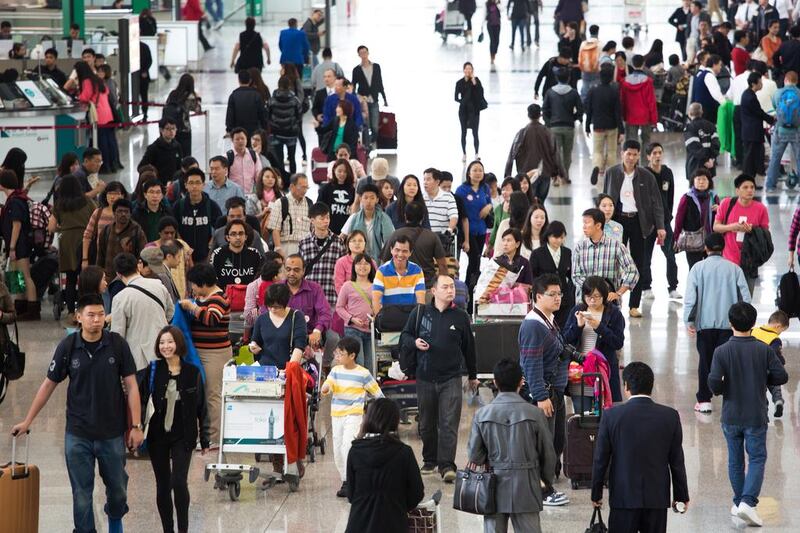As examples of Chinese air rage go, what happened at Okinawa airport on March 9 was no big deal.
Granted, the three women flying in from China should have waited until they got to Tokyo, their final destination, before deciding to go shopping. They certainly should not have strayed past the security gates in their search for the airport duty-free mall. And it is a shame that the whole airport seized up for hours while thousands of passengers had to go through security checks again.
But it was not as bad as the woman flying from Nanning to Beijing in January who claimed to have brought a bomb on board the plane, which she said she would detonate if she was not upgraded to first class immediately. Or the man who decided to cook some noodles while in flight to Hong Kong, and started throwing scalding water around when cabin crew tried to stop him.
Then there was the man who decided that he simply could not wait for the plane to complete its landing in Chongqing and forced open the emergency doors. And the group flying from Kunming in February who did the same thing – only this time while the plane was taxiing for take-off.
There were also the disgruntled passengers on a delayed flight to Dalian who “occupied” their plane on landing and refused to leave until offered compensation.
All these incidents pale in comparison with the great Zhengzhou airport riot of February 2014, when passengers incensed by delays of up to five hours formed a 2,000-strong mob and stormed the check-in counters, destroying computers and assaulting staff. Hundreds of similar violent incidents have taken place in recent years at Chinese airports, usually sparked by delays.
In at least one of them, angry passengers streamed out of the terminal and staged a sit-in protest on the runway.
The behaviour of Chinese air travellers has emerged in recent months as a national scandal. And given that an increasing number of Chinese are flying abroad for business and pleasure, the scandal is already making the rounds globally.
Many commentaries in Chinese media offer a traditional explanation: the disruptive travelleres are simply “low quality people”, propelled to wealth in a brutally competitive economic environment. This is often used as an explanation in China for everything from queue-jumping to the necessity of authoritarian government.
Others point to the specific conditions of air travel in China, where flights have increased massively but where 80 per cent of airspace is still controlled by the military.
That, and the smog that often blankets Chinese cities, can cause hours-long delays. According to a 2012 airline industry survey, about a quarter of all flights in China do not leave on schedule. Throw in a primitive understanding of customer care by Chinese airlines and you have the recipe for disaster.
And yet it may be that Chinese air rage reflects something else: the “mass incident” gone airborne.
“Mass incident” is the term used by the Chinese authorities to describe riots, staged in defence of basic rights which the participants believe have been violated by the authorities.
The trigger may be the seizure of farm land, illegal demolition of homes, particularly egregious abuses of power by local officials, or a proposal to build a polluting factory in the neighbourhood. It may be sparked by the exploitation of migrant workers or the factory boss absconding with everyone’s wages.
Whatever the cause of the particular mass incident, their numbers have grown extensively in the past decades. According to Professor Yu Jianrong at the Chinese Academy of Social Scientists, there were just under 9,000 mass incidents in 1993, 85,000 in 2005 and an astonishing 180,000 in 2011.
One reason for this is that staging a mass incident works – or at least it works better than the alternative.
In China, people who go through the established means of grievance resolution may find themselves beaten up by hired thugs, kidnapped by “interceptors” sent by local authorities on their way to petition in Beijing or incarcerated in illicit “black jails”.
It is as though doing the right thing simply identifies you as a target.
On the other hand, if you gather thousands of people, assemble outside the local government and start burning police cars – then you get a respectful hearing.
Where no crowds are available, there is always the spectacular individual gesture. Some people who have been threatened with illegal eviction have turned to self-immolation to protest.
There have also been occasions when individuals have been known to register their family’s grievance with the authorities by kneeling naked in front of city hall – a gesture which in itself, of course, is the kind of thing that could produce a mass incident.
In short, the mass incident is exactly what one might expect to take place in a society where those in power are not accountable and there is no general expectation of justice or fair dealing.
It establishes a general rule: to get what you need or want – or simply to get those in charge to listen – you have to go in hard and fast and force those in charge on the back foot .
This is the common link between the despairing peasant farmer in the Chinese countryside and the nouveau riche airline passenger.
Mass incidents are often reported as direct challenges to the authorities.
They are in fact a kind of violent conversation between the Chinese public and the powers-that-be in the absence of political reform or enforceable public rights.
Now that this conversation seems to have taken to the air, perhaps one day there may be fatal consequences.
foreign.desk@thenational.ae





